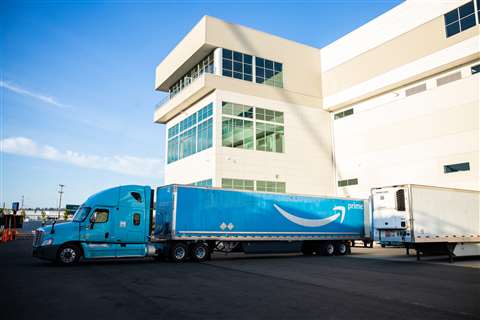Amazon places massive order for gas-fuel trucks
08 February 2022
 Amazon to replace diesel rigs with gas-fuel equivalents Photo: Amazon
Amazon to replace diesel rigs with gas-fuel equivalents Photo: Amazon
Online retail giant Amazon is reported to have ordered about 700 Class 6 and Class 8 gas-fuel trucks to help reduce the environmental impact of its logistics operations.
Engines for the trucks will be supplied by Cummins. The vehicles will also use fuel systems delivered by Vancouver-based Westport Fuel Systems (WFS). An announcement covering the dissolution of a former joint-venture between the companies was announced on 7 February, where Cummins would become sole business owner.
As part of the deal, Cummins will also buy necessary intellectual property rights from WFS for about $20 million.
The trucks being delivered to Amazon will operate on both renewable and non-renewable natural gas. Natural gas is reported to emit about 27% less carbon dioxide in comparison to diesel fuel. The trucks will be used to move goods from Amazon warehouses to the company’s distribution centres.
Logistics operations across the US are largely carried out by medium- and heavy-duty trucks. While making up about 5% of the industry road fleet, they are estimated to contribute about 20% of all vehicle emissions related to goods traffic.
In the US, COVID lockdowns caused freight activity to surge between 2019 and 2020, while over the same period passenger car use was declining.
The purchase of gas-fuel trucks follows Amazon ordering 100,000 battery-electric (BE) vans from EV start up Rivian. The first of these vehicles, which will be used for customer deliveries, are expected to be delivered in 2022.
In Europe, Amazon has ordered 1,064 gas-powered Iveco S-Way trucks to support regional logistics. As of 2021, more than 200 had been delivered, with the remainder scheduled for arrival in 2022. A further 1,800 battery-electric vans from Mercedes-Benz were ordered for Amazon’s customer delivery fleet.
Natural gas and renewable natural gas are both methane gases which when used as a fuel prevent methane from escaping into the atmosphere. Methane is said to be up to 10 times worse than carbon dioxide at causing the greenhouse effect, which traps heat in the Earth’s atmosphere.
Amazon has stated previously that it is targeting net-zero carbon emissions across the company by 2040, with the interim goal of having half of all shipments be net zero by 2030.
STAY CONNECTED




Receive the information you need when you need it through our world-leading magazines, newsletters and daily briefings.
POWER SOURCING GUIDE
The trusted reference and buyer’s guide for 83 years
The original “desktop search engine,” guiding nearly 10,000 users in more than 90 countries it is the primary reference for specifications and details on all the components that go into engine systems.
Visit Now
CONNECT WITH THE TEAM










